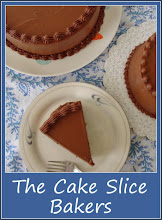Today marks 4 years since my coeliac diagnosis. It’s funny
how the knowledge and awareness of coeliac disease and gluten free diets has grown
so much in just the 4 years I have been actively conscious of it. This has had
both a positive and negative effect. The positive is that more people are aware
of it and there are becoming a lot more options for food when eating out and
choices in the shops. On the negative, people now consider it a fad, which
means some people think you are being picky when you say you need a gluten free
diet, I’ve seen many a waiter eye roll or else people start a gluten free diet
who are simply jumping on band wagon and loudly proclaim they too are eating
gluten free but then tuck into the office birthday cake or enjoy a few beers
down the pub. This gives a confusing message to people who don’t really
understand and lessens the actual severity of ensuring foods are gluten free.
On the whole it’s a positive progression though.
What better way to celebrate 4 years gluten free than with
some delicious profiteroles inspired by my gluten free pastry course fromLeiths. I tweaked the recipe a bit from the one they gave us on the course, as
the flour mix they used was a bought brand and I wanted to make my own. Also
the recipe we used on the course were for super cheesy Gougères and I wanted a cheesless profiterole.
I have tried making gluten free choux pastry once before and
it was a bit of a disaster, but fresh from my training I was willing to give
them another go. I am so pleased I did as they turned out brilliantly (even if
I do say so myself)!
To save on some arm muscles, I used a food mixer for part of
the mixing method, but I think it may have been simpler to do it by hand – not
to mention less washing up. I was worried my choux would either be doughy in
the middle, or else not puff up, but they puffed and hollowed just as they
should. They were very light and airy little puffs.
I am not a fan of plain cream, to me it’s just tasteless and
a little greasy tasting, but flavour that cream with some creamy peanut butter
and you are on to a winner. Top it off with some warm chocolate ganache and a
sprinkling of peanut brittle and I quite happily devoured 5 in one sitting – don’t
judge me, it was my first gluten free profiterole in 4 years!
The mix of light choux pastry, airy but creamy peanut butter
filling and warm bitter chocolate ganache was divine. Peanut butter and dark
chocolate are a match made in heaven and to have it all wrapped up within
little treat of a dessert was delicious. I used a mix of ricotta and double
cream for the filling, which resulted in a wonderful thick, almost moussy
peanut butter cream. I can see many more profiteroles on the horizon!
Profiteroles with Peanut Butter Cream & Chocolate Ganache
Choux Pastry
50g rice flour
20g cornflour
10g tapioca starch
¼ tsp xanthan gum
120ml water
50g butter
3 eggs
Peanut Butter Cream
150g ricotta cheese
150g double cream
2 tbsp smooth peanut butter
Chocolate Ganache
100g dark chocolate
80g double cream
1 tbsp golden syrup
Decoration
Peanut brittle
Method
Combine the 3 flours and xanthan gum together in a bowl and
mix well. Set aside.
Place the water and butter into a medium sized pan and heat
until the butter is melted. Bring the mixture to a simmer then remove from the
heat and quickly add your flour mix in one go. Immediately start to beat the
flour into the butter mixture, you need to work quickly and stir vigorously.
Continue to beat it until the mix comes away from the sides of the pan and
forms a thick dough. Keep beating until all lumps of flour are mixed in.
Then tip the dough out onto a plate and smooth out into an
even layer. This helps cool it down quickly. (At this stage the dough is known
as a ‘Panade’ a paste mixture of a soft dough).
Leave it to cool slightly for 10 minutes. Meanwhile, preheat
the oven to 220C and line a tray with silicone paper.
Once the mix has cooled slightly, return it to the pan.
Whisk the eggs together in a jug and pour this into the choux dough, a little
at a time, beating well between each addition. The mix will go sloppy, greasy
and slimy looking at each addition of egg – this is normal. Keep beating until
it absorbs the egg and then add a little bit more. Continue this until you have
a batter that reluctantly drops from the spatula when lifted. If it’s too thick
and sticky to fall off without shaking, then you need to add a little more egg.
You also don’t want it too sloppy and runny as you need to pipe it, so if you
have particularly large eggs, you may not need all of it.
It’s a hard arm workout, but keep beating until you have a
smooth sticky batter.
Scoop the batter into a piping bag fitted with a large plain
tube nozzle.
Pipe rounds of batter onto the baking tray, leaving an inch
between each one. You want them to be about the size of a large walnut.
Dip your finger in water and dab the tops of the piped choux
to flatten out any peaks formed from the piping bag.
Sprinkle a few drops of water all over the baking tray, as
this will create steam in the oven which will help them rise.
Bake in the oven at 220C for 15 minutes. Then reduce the
oven to 150C and bake for a further 8-12 minutes until they are puffed, golden
brown and lightly crisp to the touch.
Remove the choux buns from the oven, remove them from the
baking tray and make a little hole in the base of each one to let the steam
out. Cool them upside down so the steam can escape up out of the hole (or else
they go soggy)
Make the cream by beating the peanut butter into the ricotta
until smooth and well combined. Lightly whip the cream until its just beginning
to thicken, then stir this through the ricotta mixture to make a mousse-like
texture.
For the chocolate ganache, heat the chocolate, cream and
golden syrup together in a small pan. Stir gradually until the mixture is
smooth and glossy. Do not let it boil. Remove it from the heat and set aside to
cool and thicken slightly.
To serve, either pipe or spoon the peanut butter cream into
the choux buns (I like to pipe it in using the hole created in the bottom so
they stay hole.) Then dip the top of each profiterole into the warm chocolate
sauce and arrange on a plate. Roughly chop up some peanut brittle and sprinkle
a little over the top of the profiteroles.
Best eaten on day of baking. Assemble just before eating as
they will go soft if left to stand for too long.
Eat and enjoy.
Makes 16-18 profiteroles









.jpg)
.jpg)
.jpg)
.jpg)
.jpg)
.jpg)
.jpg)
.jpg)
.jpg)
.jpg)
.jpg)
.jpg)
.jpg)
.jpg)
.jpg)
.jpg)
.jpg)
.jpg)
.jpg)
.jpg)





